How to cook perfect prime rib (closed oven method)
How to cook prime rib that’s juicy, tender and perfectly cooked without a lot of fussing and fretting is easy with a simple closed oven method. Seasoned to perfection, get ready to slice off your own little (or big) bit of beef heaven and celebrate in style.

What is a prime rib?
Prime rib is a specific cut of beef that comes from the front section of the backbone of a steer (a bull that’s been castrated) called the rib primal and is primarily for support. Because the muscle doesn’t need to do a lot of work makes it very tender.
You may find prime rib under other names like standing rib roast or holiday roast and it’s the same cut used to make ribeye steaks.
What’s the difference between prime and choice beef?
The word “prime” is addressing the quality and marbling or distribution of fat throughout the lean parts of the beef. For years beef came in three choices: Prime, Choice or Select. Recently the Prime label is being used less and less and has been almost completely replaced by Choice selections at supermarkets.
When you purchase yours, ask your butcher if it is Prime or Choice–it will likely be Choice which has slightly less marbling than Prime but will still be wonderful.
Where do I buy the roast and what do I ask the butcher to do to it?
If you have a good butcher in town, start there. I don’t have any local butcher shops so I went to Kroger where there is an actual butcher. Don’t think for one minute you can stroll up to the guy who unloads sausage in the meat section at Walmart and ask him for a prime rib.
There are no butchers in any Walmart. I know some Sam’s Clubs and maybe even Costco sell them as well.
When you pick it up, make sure you tell the butcher:
- How many ribs you want. (3 ribs serves about 8-10 people)
- To take off the ribs and tie the roast to it. (You can take them off yourself, but it’s easier to let the butcher do it)
- That you’d like the cut with the biggest fat cap on it if possible.
You may not see any prime ribs out on the shelves at the store. If you don’t, just ask. It will probably have to be custom cut from meat they keep in the back. If you find one on the shelf and it has the ribs still in, just take it to the butcher counter and ask them to cut the ribs off and tie it for you.
Tools you absolutely have to have to make this work. Period.
There are only a couple of tools you need to cook a prime rib but they are essential. If you don’t have them, don’t try.
A meat thermometer. The most essential is a (affiliate link) meat thermometer. You need one that has a cable on it that keeps one end on your counter and one end in the meat or a fancy one that connects to your phone would also work. You just can’t be opening the oven to check things so use one that keeps the display where you can see it constantly. Meat thermometers are not expensive and will tell you exactly when your standing rib roast is ready. (affiliate link) This one is affordable, easy to use and does the job.
A roasting pan. You need a pan made for roasting. You won’t need the metal rack they come with (the ribs of the beef serve that purpose) so just set that to the side. Roasting pans are just deep enough to catch the splatters but not so deep that they hold in steam and make your meat soggy on the outside. (affiliate link) I like this affordable one in stainless steel to avoid the chemicals in non-stick pans.
How many people will one prime rib feed?
Portion sizes of prime rib are referred to as the number of “ribs” or “bones”. The thickness of three ribs will feed 8-10 people depending on how many side dishes and extras you have. Most butchers estimate one pound per person–that’s a lot of meat for me but you’ll know your people and how much they eat better than anyone.
I served a three rib, 8-pound roast to my family of 7 and had one pound left over and they were HUGE eaters so that’s pretty close to on par with one pound per person.
What temperature do I cook my beef to?
Beef is it’s most juicy and flavorful between 130 and 135. That’s medium/medium rare. Prime rib should never be cooked to well done. If you have people you’re serving who don’t like pink in their meat, serve them the edge slices. Those will be more well done.
With the closed oven method, my prime rib didn’t increase in temperature once I took it out of the oven but if you use another method you can expect your meat to increase in temperature by up to 10 degrees after you take it out so plan accordingly and remove it a few degrees cooler than you’d like it to be.
Use this guide to determine what temperature you’d like your prime rib to be:

How to prepare prime rib for oven roasting step-by-step
Step 1: Bring your prime rib roast to room temperature. If your roast is cold in the center it will make it hard to roast evenly. Bring your roast out 3-4 hours before you want to cook it and leave it on the counter. I know that feels terrible to do but it’s okay, I promise.
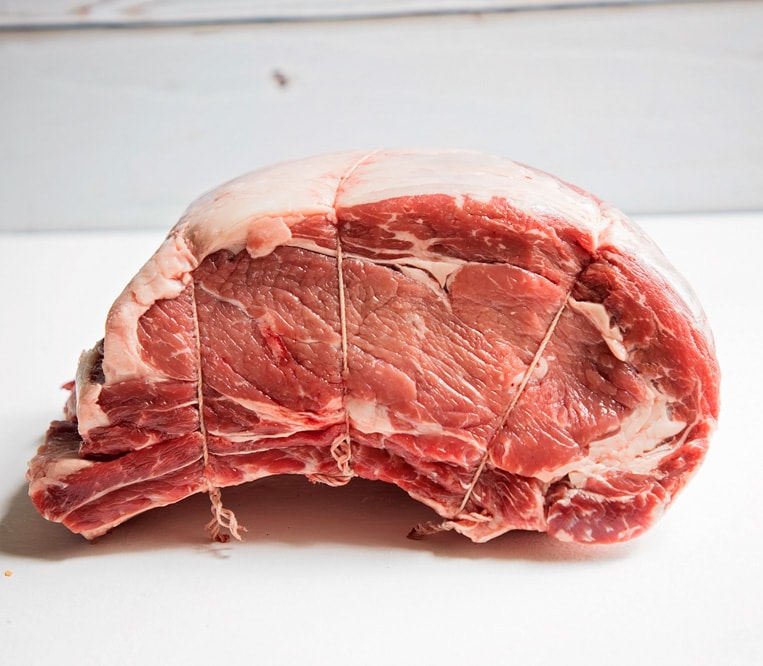
Step 2: Preheat the oven to 500 degrees and prep the meat. Rub the roast all over with butter (a note on this to come) and a blend of Herbs de Provence. This is a spice blend you can find in just about any grocery store or here on Amazon. Then sprinkle with kosher salt until it’s evenly coated on all sides. Don’t be stingy with the salt. I used a couple of tablespoons on an 8 pound roast. Lay the roast (rib side down) into a rimmed roasting pan and insert a meat thermometer into the thickest portion, not touching any bone.

Step 3: Slice 4 russet potatoes in to 1/2″ or thicker pieces and lay them around the meat. You don’t have to eat these (but Lordy they are delicious)–they are only there to catch the butter drips and prevent any fat that drips off from smoking and burning. Try to just get an even layer of potatoes in your baking pan.

Step 4: Calculate your cook time. You need to estimate 5 minutes per pound. Look at the label that came on your meat to know exactly how much it weighs. Multiply that number times 5 and that’s the number of minutes to cook your roast at 500 degrees. My roast was 7.95 pounds x 5=39.75 minutes or 40 minutes total.
NOTE: If you have a large roast you plan to split into two, as long as you have plenty of space between them for air to circulate, you can treat them as a single roast. Example: A 16 pound roast split into two 8 pound roasts would cook for 40 minutes.
Step 5: Roast and monitor. Cook the prime rib at 500 degrees for your calculated time then turn the oven off and do not open the door. I mean it. Do not open it for anything for 2 hours. During that time, watch your thermometer–you are aiming for a roast that’s about 130 degrees before you take it out of the oven. Read below for steps to take if your oven cools off to quickly.
Step 6: Rest. Once your beef reaches 130 degrees, remove it from the oven, try not to drool all over yourself and let it rest uncovered until the internal temperature is 120 degrees. Just leave your meat thermometer in it and wait. This step took an entire hour for me so make sure you plan for it. You don’t want those precious juices rolling out all over your counter.
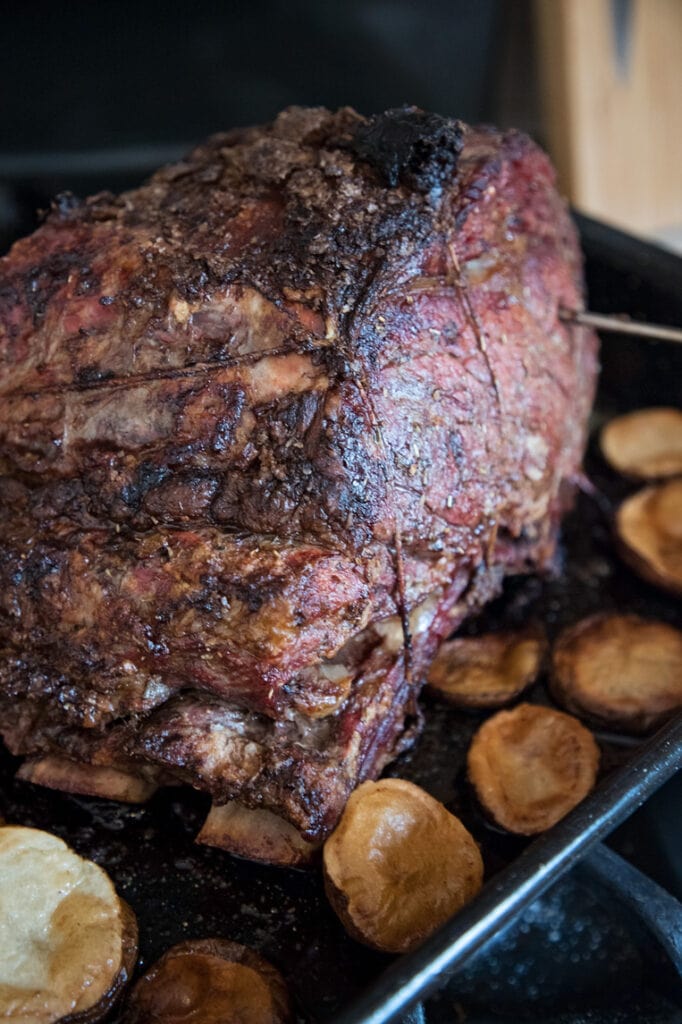
What to do if your oven cools off too quickly and your meat stops cooking
The closed door method for cooking prime rib is supposed to be simple and it is for the most part. But today’s ovens create some challenges with this method (which was created ages ago when ovens were solid) because most just don’t hold heat like they used to and some come with fans in them that automatically kick on to cool an oven down after use. If you have an oven with an automatic fan, this method may not work for you.
When cooking mine, I wanted my meat to get to 130 degrees. After one hour with the oven off it reached 125 and I was worried it would overcook. But it sat there. And sat there. After 20 minutes the temperature hadn’t budged. You should see the temperature on the meat going up a degree or two every 10 minutes or so and mine had stalled. If yours stalls or starts to drop at all, take action.
To fix this problem:
- Keep the door closed but turn the oven to 270 degrees. When mine kicked on to preheat, sure enough the temp was 125 inside. Way too cool.
- Allow the oven to preheat to 270 and leave it on at that temperature for 5 minutes, then turn the oven off again. It may take 5 or 10 minutes for the heat to begin to penetrate but watch your meat thermometer and don’t sweat it.
- When your prime rib gets to 130, just take it out even if the 2 hours aren’t up yet. Mine came out 15 minutes early and was still perfect.
If your meat was really cold when you put it in the oven initially, you may have to do this process a couple of times or leave your oven on 270 for 10 to 15 minutes to really help the prime rib get going. Remember: you won’t ruin it as long as you don’t overcook it. You have a meat thermometer to help you with that, so you’ll do fine!
What to serve with prime rib
Above all, you must have horseradish sauce. I make mine from just good mayonnaise and prepared horseradish but you can also buy it pre-made. Don’t you dare put A-1 on something this delicious. (My daughter does but we won’t talk about that.)
Next, you’ll want to balance the richness of the meat with some lighter items. Try reading up on 25 of my favorite side dishes for beef tenderloin. You’d also like:
- Pear and Gorgonzola Salad
- Sautéed green beans with mustard and shallots
- White cheddar popovers
- Browned butter brussel sprouts
Plan the perfect meal with these side dishes

How to cook perfect prime rib (closed oven method)
Equipment
- Oven thermometer with attached probe
Ingredients
- 1 8 pound standing rib roast (prime rib) *See Note 1
- 1/2 cup butter softened, *See Note 2
- 2 tablespoons herbs de provence
- 2 tablespoons kosher salt
- 3 large russet baking potatoes
Instructions
- Remove the prime rib from the refrigerator 3 to 4 hours before cooking so that it can come to room temperature.
- When ready to roast, preheat the oven to 500 degrees and move your oven rack to the lower third.
- In a bowl, mix the butter and herbs de provence. Cover all surfaces of the meat.
- Generously coat the surface of the meat in kosher salt.
- Place the roast ribs down into a roasting pan and insert a meat thermometer into the center of thickest section, not touching the rib bones on the bottom.
- Wash the potatoes and slice them in to 1/2" slices. Lay them in an even layer around the prime rib to catch drips and prevent the butter from smoking and burning.
- Roast your prime rib at 5 minutes per pound. (For an 8 pound roast that's 40 minutes). Then turn the oven off and leave the door closed for two hours.
- Monitor the temperature of the meat. If the temperature fails to climb for 15 minutes or begins to fall, turn the oven back on 270 degrees for 5 minutes then turn it off again. Wait 10 minutes for the heat to reach the center of your prime rib. Continue to monitor your meat and make sure the temperature slowly climbs a degree or two every 5 to 10 minutes. If it doesn't turn the oven back on in bursts until you reach your desired degree of doneness. In this case that was 130 degrees.
- Remove the prime rib from the oven and leave the meat thermometer inside. Allow the roast to cool to around 120 degrees before slicing, but it's fine to slice it sooner if needed. That process can take up to an hour depending on how large it is.
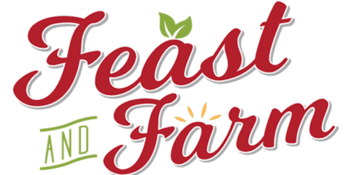


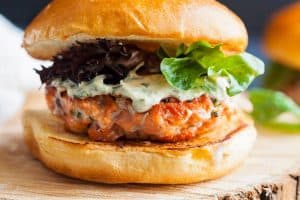
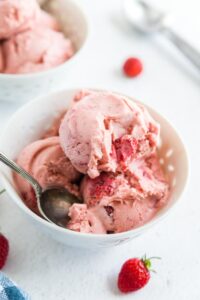
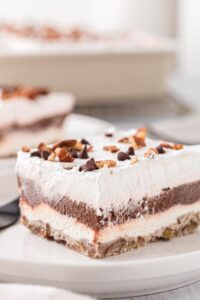
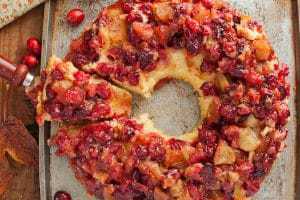
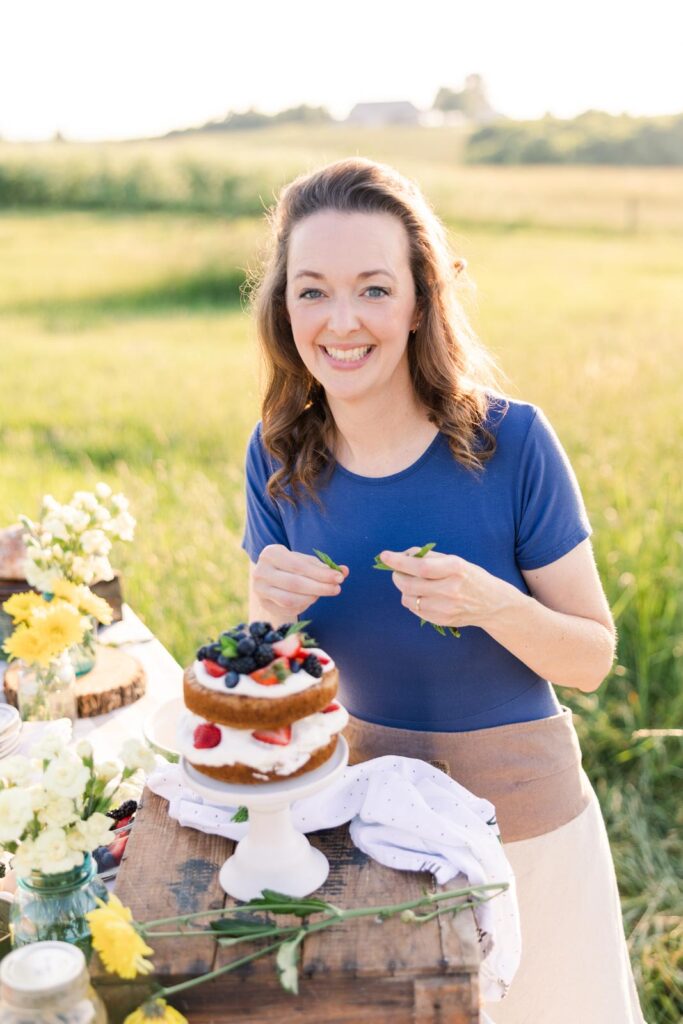
I always broil my prime rib at 500 degrees I do 5 minutes per pound then I shut my oven off for 2 hours .
I always get the nicest prime rib medium rare I told my friend to do the same thing.
However, friends are telling her not to broil but bake so she’s getting conflicting information.
Any advice ???
I bake mine and don’t broil but whatever method your friend wants to use is up to her. If I broiled mine I think I’d burn my house down but there’s not a hard and fast right way to do it. –Rachel
Can you use this method of cooking a standing rib roast if you dry aged it? I read that it can cook quicker? I have used your method every year but, was wanting to try dry aging it first. Thank again!!
Hey Lenore. I don’t know on the dry aging. I’d certainly do some research online and follow what you find there. I think it’s great that you dry aged yours! –Rachel
I took out my 6.5 lb roast 50 minutes ago and it has not dropped in temperature. After taking it out, it went to 133 about 15 minutes after taking it out and has not fallen from that. I have now resorted to placing the roast in my 50 degree garage to try to cool it down before I end up ruining my side dishes waiting for the roast to cool down to 120. I ended up carving up the roast at 127.
I placed garnet yams in the bottom of the roasting pan and they are divine- tasted one after taking the roast out of the oven after sitting for 2 hours. They are nicely caramelized on the bottom. I did have drippings that I will be able to use to make an au jus.
I will make the this again to get the wonderful yams. The prime rib came out fine, nicely pink thru out.
Yes that heat takes a long time to penetrate the center so it’s good to anticipate that additional rise and take your meat out early if you want your beef more rare. I’m glad you enjoyed it! –Rachel
I took it out when it got to 130° and the temp continued to go up and up to 142°.. how do I stop from continue cooking?
Hi Fred, it will continue to rise as heat penetrates the inside of the meat. You can’t stop it unfortunately and the best method is to take the meat out earlier and let it rise to the desired temperature. It’s a bit of a guessing game on how that will work. My meat usually only rises two or three degrees and stops. Some people have no rise after removal from the oven and others have steep rises like you did. I think the size of the beef and the intensity of the oven’s residual heat make the difference so next time you’ll know to pull yours when it’s ten or so degrees from being done and then you can watch it to see if it gets to the temperature you need.
I’ve used this method for years and it is always delish. Can you give me some direction if I’m trying to cook 2 prime ribs (5lbs each) at once?
I think you can do it Diem. Just give each one several inches of space so air can circulate evenly and of course use a meat thermometer (ideally one in each piece of meat) but at least in one so you can track the progress accurately. –Rachel
My prime rib turned out exactly the right pink but not nearly so tender as I remember from Vegas restaurants. Also, no juice at all. any pointers
Hey Dave, I guess there could be a lot of factors that go in to that. First would be the quality of the beef you buy from your store vs. what a specialty restaurant is going to have access to. Tenderness can be directly related to how the cow was raised. The other issue with juice–do you mean in the bottom of the pan or the meat itself? If you meant the meat, you have to make sure you really let this meat rest. A while. 30…45 minutes would be fine. It takes a while for those juices to redistribute in a piece of beef this large. Usually mine is very juicy and tender enough to cut with a fork. –Rachel
is there a weight limit for the beef.
im tring it with a 2.5 lb prime rib
Hi Maureen, I think I covered sizes in the contents of the blog post but I think it’s just hard to regulate the temperature on anything much over 4 or 5 pounds. –Rachel
hi, Rachel. Dave again. I got it at Costco and it was choice ribeye boneless roast. Like you mentioned in the article, there was no prime to be had, but I know a local butcher shop that probably has prime if that’s what it takes. But it is definitely not fork tender.
Also, it was fairly juicy, but no juice at all in the pan to pour over it. Is the au jus something that has to be made separately? Or did I make a mistake not putting a lid on the pan? I know my mother used to make brisket all the time and she would wrap it tight in foil and there was always a ton of extra juice.
I see–thanks for your clarification on that Dave. Any drippings will be absorbed by the potatoes in the bottom. If you used those, then that’s where it all went. It’s a bit of a two edged sword because without the potatoes the butter is going to burn and smoke your house up. But with them, there are no drippings to gather. One way you may get at least a few drippings is to ask your butcher for the end of the prime rib that has the larger fat cap on top. And no you didn’t make a mistake by leaving off the lid. If you cover it, it’s going to steam and be gray. It will never crust over as it should on the outside. A brisket is a tough piece of meat that needs a long slow cook. We cover those to hold in moisture in a process we call braising. Prime ribs should never need that process.
If you love the recipe but want a sauce, you could always make an au jus with beef broth. I haven’t tried it but there are lots of recipes online. I think the key would be getting a very high quality broth to start with or making your own homemade to have on hand for situations like this. –Rachel
Love to cook Prime roast this way but the grease splatter all over the oven. would making a foil tent over it make any difference in the cooking?
Did you use the potatoes in the bottom Donna? I don’t have any splatter as long as those are in place. I’m afraid foil would cause your meat to steam and not get brown. –Rachel
Thanks Rachel. That clears some stuff up. I guess why mine was a little tough it wasn’t prime. I do think I know a shop that would have prime so I’ll try them.
This is the absolute best way to cook a prime rib! With all of your carefully thought through directions, I was able to punt even though the internal temperature of my roast was only 32 degrees when I slapped it in the oven. I just adapted as I went after seeing the the temp wasn’t rising quickly enough for the roast to get to 130 deg. after 40 min. I alternated between 270′ and 350′ until it reached 120 deg.
In the end, it was delicious and received nothing but praise. Obviously, next time I’ll use the probe to make sure the roast is entirely thawed and at room temperature. Grrr!
Way to go Cynthia. You certainly do want to let it warm up if you can. Two or so hours at least so that you don’t have to do so much revving of the oven to get to your desired temperature but you did awesome at thinking on your feet there! I’m so glad you all enjoyed it! –Rachel
My meat thermometer melted at 500 inside my roast. Very nervous about knowing the temp??!! 8 lbs. I set timer for 40 minutes. Is there any other way I can tell if it is done? Afraid to open it.
Oh NO Karen! That’s horrible. Send someone to the store for a new one while you wait. There’s absolutely no other way to do this without knowing that internal temperature. If you can get a new one or borrow one from a neighbor open the door fast and stick it in then shut it fast and be prepared to maybe turn the oven back on in bursts until you reach your desired temperature.
my bet is you used a digital thermometer with the plastic LED readout on the handle. that’s why it melted. you need a “probe” thermometer with the LED readout that sits on the counter..it attaches one end to the other via cable that can withstand heat.